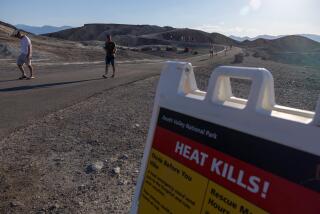Experienced Hiker Died of Bite : Family Tragedy Spurs Rattlesnake Symposium
- Share via
Ray Bogowitz had traveled the mountain ranges in Baja California many times throughout his life, searching and studying a vast number of Indian cultures and their artifacts.
Yet the experienced 58-year-old hiker apparently had no idea what to do if he ever came across a rattlesnake during the archeological digs, according to his daughter, Cheri Bogowitz. Last June, the elder Bogowitz, who was leading an expedition near Mike’s Sky Rancho in the mountains southeast of Ensenada, was bitten on the leg by a large rattler. He died several hours later.
As a result of that tragedy, his family and friends have vowed to do everything they can to prevent another rattler from ever killing anyone, and they made good on that vow Wednesday night when the Natural History Museum presented a symposium titled “Rattlesnakes: Their Natural History, Snakebite Prevention and Treatment.”
The symposium was made possible by $2,000 raised by Bogowitz’s friends and family, said museum spokeswoman Connie Meyers.
“It’s still very painful for me (a year after my husband’s death),” said Gloria Bogowitz. “The only reason we wanted to have this symposium was because of how my husband died.”
Cheri Bogowitz said her father, who graduated from San Diego State University with a bachelor’s degree in geology, always loved to travel south of the border. Although he carried first-aid kits, his last concern seemed to be the presence of snakes in his path, she said.
“He never mentioned or ever dreamed about being bitten,” she said. “My father was in the lead (of an expedition) when he got bitten.”
The Bogowitz family said it also will try to arrange better methods of communication between Mexican and American officials so medical aid can be more quickly dispatched to American tourists bitten by snakes or suffering from other medical emergencies. In Ray Bogowitz’s case, the U.S. Coast Guard arrived about 24 hours after he was bitten, the family said.
Cheri Bogowitz said the symposium was particularly important because it dealt with the start of the rattlesnake season and the increase in the rattlesnake population in San Diego County.
According to literature and experts on herpetology, the only venomous snakes in San Diego County are rattlers, specifically the Southwestern speckled, the Colorado desert sidewinder, the red diamondback and the Southern Pacific.
These species exist, except in extreme desert areas, from San Diego County north to Kern County, and as far south as Baja California.
The Southern Pacific is the greatest public health threat because it is the most commonly encountered. It also is considered the most aggressive, and its venom is very potent.
The Southern Pacific and the red diamondback have a variously defined diamond-shaped pattern of contrasting blotches, and are the largest of the four species. The speckled and sidewinder are much smaller and lighter-colored snakes, with an indistinct speckled pattern and tan or buff-colored blotches on a cream ground color, respectively.
Rattlesnakes can strike with the mouth closed, or can penetrate the skin with fangs and inject no venom. These are called “dry” bites, and usually occur when they’re annoyed and don’t feel seriously threatened. Contrary to popular belief, rattlesnakes don’t always rattle before striking.
The best way to avoid being bitten is to never step into or put your hands in unseen places, such as behind or between rocks and logs. Also, herpetologists suggest that hikers wear long pants and hiking boots when camping in the isolated countryside.
Doctors and herpetologists say that if a snake bites, the victim will feel a sharp, burning pain at the site of the bite, followed by a spreading swelling, skin discoloration and a tingling sensation.
The victim should stay as calm and as still as possible, and the area of the wound should be immobilized while he or she is transported to the nearest hospital.
If the victim is within 45 minutes of the hospital, nothing more should be done in the field. But if the victim is farther away from the hospital, a constriction band, which is looser than a tourniquet, can be used to retard the spread of venom through the blood. In addition, an incision should be made in the wound and the venom sucked out.
The band should not be applied too tightly or for more than a few hours.
More to Read
Sign up for Essential California
The most important California stories and recommendations in your inbox every morning.
You may occasionally receive promotional content from the Los Angeles Times.










